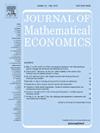How to build and solve continuous-time heterogeneous agents models in asset pricing? The martingale approach and the finite difference method
IF 0.7
4区 经济学
Q3 ECONOMICS
引用次数: 0
Abstract
This paper serves as a tutorial, offering a step-by-step guide for building and numerically solving a preference-heterogeneous agent model in asset pricing. Using a three-stage framework, we clarify the modeling and solution process through a detailed example. Within this framework, we demonstrate how to apply the finite difference method with implicit and upwind schemes to solve the partial differential equation for stock prices, thereby deriving the optimal portfolio, equilibrium asset prices, and their volatility. Additionally, we explore other contexts where this numerical method can be applied, including models with preference heterogeneity using dynamic programming, external habits, and incomplete markets with income heterogeneity and recursive utility. We also address practical considerations in its implementation. This paper does not cover models that incorporate both aggregate and idiosyncratic risks.
如何建立和求解资产定价中的连续时间异构代理模型?鞅法和有限差分法
本文作为一个教程,为构建和数值求解资产定价中的偏好-异构代理模型提供了一步一步的指导。使用三阶段框架,我们通过一个详细的示例阐明了建模和解决过程。在这个框架内,我们展示了如何应用隐式和逆风方案的有限差分方法来求解股票价格的偏微分方程,从而推导出最优投资组合、均衡资产价格及其波动率。此外,我们还探讨了该数值方法可以应用的其他情况,包括使用动态规划的偏好异质性模型、外部习惯和具有收入异质性和递归效用的不完全市场。我们还处理其执行中的实际考虑。本文不涉及同时包含总体风险和特殊风险的模型。
本文章由计算机程序翻译,如有差异,请以英文原文为准。
求助全文
约1分钟内获得全文
求助全文
来源期刊

Journal of Mathematical Economics
管理科学-数学跨学科应用
CiteScore
1.70
自引率
7.70%
发文量
73
审稿时长
12.5 weeks
期刊介绍:
The primary objective of the Journal is to provide a forum for work in economic theory which expresses economic ideas using formal mathematical reasoning. For work to add to this primary objective, it is not sufficient that the mathematical reasoning be new and correct. The work must have real economic content. The economic ideas must be interesting and important. These ideas may pertain to any field of economics or any school of economic thought.
 求助内容:
求助内容: 应助结果提醒方式:
应助结果提醒方式:


